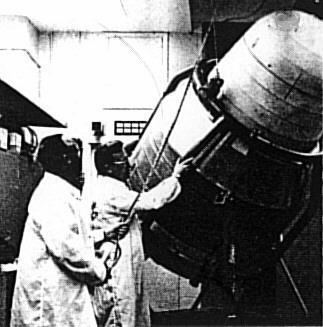Mission type Bioscience COSPAR ID 1966-114A Mission duration 30 days | SATCAT no. 02632 | |
 | ||
NASA launched three satellites named Biosatellite 1, 2 and 3 between 1966 and 1969.
Contents
NASA's Biosatellite program was a series of three satellites to assess the effects of spaceflight, especially radiation and weightlessness, on living organisms. Each was designed to reenter and be recovered at the end of its mission.
Its primary goal was that it intended to determine effects of space environment, particularly weightlessness, on life processes at three levels of organization: basic biochemistry of the cell; structure of growth of cells and tissues; and growth and form of entire plants and animals.
Biosatellite 1
The Biosatellite 1, also known as abbreviated Biosat 1 and as Biosatellite A, was a first artificial satellite unmanned U.S. belonging to Biosatellite program for biological research. It was released on December 14, 1966 by a rocket Delta G from Launch Complex 17A of the Cape Canaveral Air Force Station. The Biosatellite 1 was the first series Biosatellite satellites. It was released in an initial orbit of 296 km perigee 309 km apogee and 33.5 degrees degrees of orbital inclination, with period 90.5 minutes.
The Biosatellite 1 was carrying several specimens for the study of the effects of the space environment on biological processes. The capsule was returning to land separated from the vehicle properly, but his rocket did not work, for which it was not possible to recover the capsule as expected and did not obtain scientific data. Reentered the atmosphere uncontrollably due to atmospheric drag, on February 15, 1967.
Biosatellite 2
The Biosatellite 2, also known as abbreviated Biosat 2 and as Biosatellite B, was a second artificial satellite unmanned U.S. belonging to Biosatellite program for biological research. It was released on September 7, 1967 by a rocket Delta G Launch Complex 17B of the Air Force from Cape Canaveral station.
The Biosatellite 2 was carrying 13 Biological experiments that used insect, frog eggs, plants and microorganisms. The capsule returned ahead of time because of the tropical storm threat in the recovery area and communication problems between the capsule and ground stations. The main objective of the mission was to determine if the level of radiation sensitivity of living organisms in space is greater, or less than on land, for which disposed of a radiation source in front of the capsule.
Biosatellite 3
The Biosatellite 3, also known as abbreviated Biosat 3 and as Biosatellite D, was a third artificial satellite unmanned U.S. belonging to Biosatellite program for biological research.
The intent had been to fly a 6 kg male pig-tailed monkey (Macaca nemestrina) named Bonnie in Earth-orbit for 30 days. However, after only 8.8 days in orbit, the mission was terminated because of the subject's deteriorating health. High development costs were a strong incentive for maximising the scientific return from the mission. Because of this, the scientific goals had become exceedingly ambitious over time, and a great many measurements were conducted on the single research subject flown. Although the mission was highly successful from a technical standpoint, the science results were apparently compromised.
Despite the seeming failure of the mission's scientific agenda, Biosatellite 3 was influential in shaping the life sciences flight experiment program, pointing to the need for centralised management, realistic goals and substantial pre-flight experiment verification testing. The mission objective was to investigate the effect of space flight on brain states, behavioural performance, cardiovascular status, fluid and electrolyte balance, and metabolic state. Biological capsule reentered in 7 September 1969.
